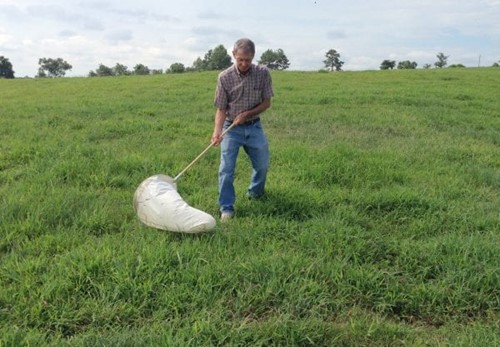Fall armyworms (Spodoptera frugiperida) are a common pest in North Florida that can devastate a grass or forage crop. The fall armyworm is a part of the insect family Noctuidae. You can identify the caterpillars by the inverted Y-shaped marking on their head (Figure 1). Adult armyworms will be an ash-gray moth of about 1 ½ inch in size. Fall Armyworm moths move north in wind currents from South Florida, Texas and South American to the Southeastern United States in the late summer-early fall. The excessive amounts of rain that North Florida has received in the past few months has created perfect conditions for the young caterpillars to survive. However, elevated temperatures and drought conditions promote the older caterpillars. Fall armyworm populations in our area will die off with the first cold snap of the year.

Figure 1: Depicting the inverted Y-Shaped marking on the head of fall armyworms. Photograph by Lyle J. Buss, University of Florida.
–
Fall armyworm damage will occur in your hayfields and pastures primarily from August through October. You may also see an outbreak in late spring when temperatures begin to rise. The caterpillars will damage grass by eating the blades (leaves). Damage in hayfields and pastures will vary from defoliation to total plant loss. Lush, well fertilized forage crops like bermudagrass hayfields are preferred by fall armyworms. Established perennial forages are rarely killed, however, the damage caused will weaken the plant and cause it be less desirable for livestock to eat, or will considerably reduce hay yield. Young winter annuals such as ryegrass, rye, and oats are susceptible to being stunted or killed, if the caterpillars feed too far down on the plants stem.
Damage from the caterpillars will come in waves of about 30 days. If your pastures or hayfields have not been severely damaged, fertilization is recommended to stimulate growth for grazing or another hay cutting. Severely damaged crops should be allowed to rest and closely monitored for the rest of the season.
Using an insect sweep net to pass through the forage grass is the best way to scout for fall armyworms (Figure 2). A sweep net is highly effective because it can pick up armyworms of any size in their lifecycle. For the best possible results, it is best to use your sweep net in the early morning or late afternoon, as that is the time the young armyworms will be most active. The best practice is to sweep your net in an area of about 1 square foot. If your sample shows that there are more than two to three armyworms per square foot, it is time to cut your hayfield or apply insecticide to your pastures. If you do not have a sweep net, bend down on one knee and part the grass to look for worms as they roll up and drop to the ground as a defense mechanism.

Figure 2 – Depicting using a sweep net to sample fall armyworms in a hayfield. Credit: Management of Fall Armyworm in Pastures and Hayfields
–
It is important to scout and see what stage of the lifecycle the armyworms are in because that will affect how you are going to treat your pastures and hayfields. Small armyworms are a lot easier to kill than hardier larger caterpillars. Frequently cutting your hayfields is the best way to save a crop if you do not want to use chemical control. Caterpillars will continue to feed on cut hay as it dries, but the process of cutting hay will kill an abundance of the larger caterpillars. If the population is too high, then chemical control may be required.
It is important to consider whether you are planning to spray insecticide on perennial grass or annual grass, as there is a varied range of products specified for use on either grass type. Not all insecticides are labeled for use on all types of grass – make sure you read the label. If you are grazing a pasture, it is best to use an insecticide with the shortest grazing restriction available.
–
Insecticide Options – No Pesticide License Required
Insecticides for grazing and hay fields with the active ingredients of Spinosad (Blackhawk) and Chorantraniliprole (Prevathon) are highly effective for quick control of armyworms that do not require a pesticide applicators license. If you are looking for insecticides with the longest residue that will help with future outbreaks, the active ingredient methoxybenzene (Intrepid) is effective. A rescticted-use pesticide applicators license is also not required for Methoxybenzene.
–
Insecticide Options – License Required
There are a variety of pyrethroid products available that can provide fast and relatively cost effective control of army worms, but these products do not provide any residual control. Products containing diflubenzaron (Dimilin 2L) are slower to act but provide a period of residual control after application. It is common to apply a pyrethroid and difulbenzaron together to achieve the “knock them down and keep them down” effect. More options are provided in the publication: Management of Fall Armyworm in Pastures and Hayfields.
Regardless of product used it is important to check the label on the insecticide container to confirm it is appropriate for a grazing/hay system, and always be sure to use the recommended application rate, and method. Always follow all PPE (Personal Protection Equipment) guidelines when applying insecticide.
–
Sources:
-
fall armyworm, Spodoptera frugiperda
–
-
Management of Fall Armyworm in Pastures and Hayfields – Alabama Cooperative Extension System
–
-
Fall armyworm: Biology and Management in Georgia Turfgrass
- Soil Testing, a Key Component of Panhandle Pasture Management - March 14, 2025
- Pasture & Hayfield Fall Armyworm Control - September 20, 2024
- 2024 Jefferson County Pasture Walk Recap - April 5, 2024
